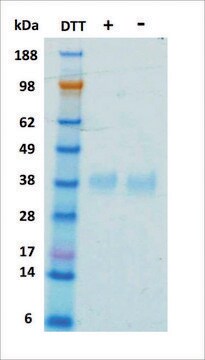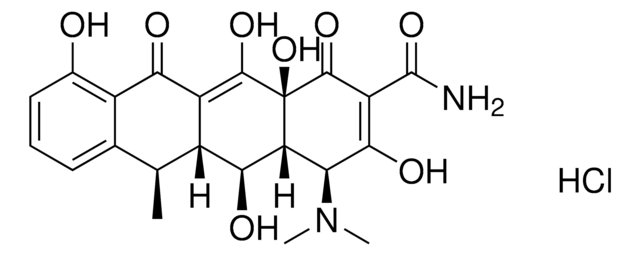Key Documents
E5546
Erythropoietin (EPO) human
recombinant, expressed in HEK 293 cells, suitable for cell culture
Synonim(y):
EPO, epoetin, hematopoietin, hemopoietin
About This Item
Polecane produkty
rekombinowane
expressed in HEK 293 cells
Próba
≥98% (SDS-PAGE)
Postać
lyophilized powder
siła działania
≤2.5 ng/mL ED50 (measured in a cell proliferation assay using TF-1 human cells)
metody
cell culture | mammalian: suitable
zanieczyszczenia
Endotoxin, tested
temp. przechowywania
−20°C
Opis ogólny
Działania biochem./fizjol.
EPO consists of 165 amino acids and has a high carbohydrate content, of both N-linked and O-linked types. The oligosaccharide chains are responsible for EPO production, secretion, longevity, and functioning. The biological activity of EPO depends upon two disulfide bonds, one formed between cysteine7 and cysteine160, and the other between cysteine29 and cysteine33. Thus, EPO proper folding, glycosylation and disulfide bonds formation are crucial for its function.
EPO was found to downregulate HIF-1α in the diabetic rat model. EPO helped maintaining the homeostasis of intracellular zinc in retinal cells, altered as a result of diabetes, by restoring Zinc transporter 8 (ZnT8) expression.
Kod klasy składowania
11 - Combustible Solids
Klasa zagrożenia wodnego (WGK)
WGK 2
Temperatura zapłonu (°F)
Not applicable
Temperatura zapłonu (°C)
Not applicable
Certyfikaty analizy (CoA)
Poszukaj Certyfikaty analizy (CoA), wpisując numer partii/serii produktów. Numery serii i partii można znaleźć na etykiecie produktu po słowach „seria” lub „partia”.
Masz już ten produkt?
Dokumenty związane z niedawno zakupionymi produktami zostały zamieszczone w Bibliotece dokumentów.
Klienci oglądali również te produkty
Nasz zespół naukowców ma doświadczenie we wszystkich obszarach badań, w tym w naukach przyrodniczych, materiałoznawstwie, syntezie chemicznej, chromatografii, analityce i wielu innych dziedzinach.
Skontaktuj się z zespołem ds. pomocy technicznej












